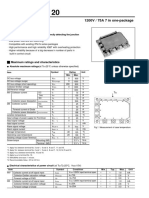LFI7 GasBControl
LFI7 GasBControl
Uploaded by
sanduzCopyright:
Available Formats
LFI7 GasBControl
LFI7 GasBControl
Uploaded by
sanduzOriginal Title
Copyright
Available Formats
Share this document
Did you find this document useful?
Is this content inappropriate?
Copyright:
Available Formats
LFI7 GasBControl
LFI7 GasBControl
Uploaded by
sanduzCopyright:
Available Formats
7 428
Gas Burner Controls LFI7...
Series 03
ISO 9001
Gas burner controls for single-stage burners of small capacity in intermittent
operation.
For safety reasons (self-testing of the flame supervision circuit, etc.), at least one
controlled shutdown must take place every 24 hours.
The LFI7... and this data sheet are intended for use by OEMs that integrate the
burner controls in their products!
Use The burner controls of the LFI7... range are used for the automatic startup and
supervision of single-stage forced draught gas burners.
Only for use (replacement) on existing plants:
– To DIN 4788 (Europe)
– To DIN 4788, or also
– For air heaters to DIN 4794
Program variants LFI7.13 with control program for flash-steam generators
LFI7.33 with normal control program for heating plants, etc.
LFI7.35 with control program for forced draught or atmospheric gas burners
Mechanical design The burner controls are of plug-in design, suitable for mounting in any orientation on the
burner or boiler, as well as in control cabinets and on control panels. The housing is made
of impact-proof and heat-resistant plastic and contains:
– The flame signal amplifier with its flame relay
– The electro-thermal timer that acts on a multiple snap-action switching system
(ambient temperature-compensated)
– An electronic delayed action auxiliary relay, and
– The reset button with an integrated lockout warning lamp
The burner controls have a control output for optical and audible remote indication of
faults.
For mechanical design of the base, refer to «Installing the burner control».
Landis & Staefa CC1N7428E December 15, 1997 1/7
Flame supervision Flame supervision - using the conductivity and rectification effect of burning gases - is
ensured by the application of an a.c. voltage to a detector electrode of heat-resistant
material immersed in the flame. The current (ionization current) which flows in the
presence of the flame generates the flame signal which is fed to the input of the flame
signal amplifier. The latter is designed such that it reacts only to the d.c. component of
the flame signal. This ensures that a short-circuit between detector electrode and earth
cannot simulate a flame signal (as in this case an a.c. signal would be generated).
The circuit of the flame signal amplifier is also so designed that brief arcing-over of the
ignition spark to the detector electrode (or high voltage peaks entering the detector
circuit) cannot impair the supervisory functions of the burner control.
The insensitivity of the flame supervision circuit to possible negative effects of the
ignition sparks on the ionization current ensures optimum startup conditions.
Electrical connections It is important to achieve practically loss-free signal transmission:
of the detector – The detector connecting cable should not exceed 20 m in length
electrode – The detector cable should not be laid in the same conduit with other conductors, as line
capacitance may reduce the magnitute of the flame signal
– The insulation resistance between detector electrode and earth must remain above
50 MΩ even after long periods of operation. Prerequisite for the latter is not only the
use of high-grade heat-resistant insulation for the detector cable, but also for the
detector electrode itself (ceramic holder!)
– Soiled detector electrode holders encourage creepage currents, which reduce the
magnitute of the flame signal
– The burner (as the counter-electrode) must, according to regulations, also be earthed,
otherwise no ionization current can flow; earthing of the boiler alone is often
insufficient!
– The line and neutral connections to terminals 1 and 2 of the burner control are not
interchangeable. Incorrect line connection will prevent generation of the flame signal!
Functions When the control thermostat or pressurestat «R» closes its contact, which supplies
power to the burner control, the burner motor is switched on. However, the LFI7... begins
to program the pre-purge time «t1» only when the air pressure monitor «LP» closes its
contact.
During the pre-purge time, the functioning of the flame signal amplifier is automatically
checked by means of the flame relay test (energizing / de-energizing the relay). Lockout
occurs if the test is unsuccessful.
On completion of the pre-purge time «t1» and the short pre-ignition time «t3», the gas
valve is opened. This starts the safety time «t2», during which the burner must fire. If the
flame supervision circuit has not registered a flame signal before the safety time is
completed, the gas supply is immediately interrupted and lockout occurs shortly
afterwards.
Because of the combination of electronic and thermal time control, the minimum and
maximum switching times quoted below are reproduced with great accuracy - in spite of
supply voltage variations, changes of ambient temperature or quick successions of
shutdowns and restarts.
2/7 CC1N7428E December 15, 1997 Landis & Staefa
Switching times LFI7.13 LFI7.33 LFI7.35
A Startup (control circuit closed by «R»)
t1 Pre-purge time min. 8s 30 s 30 s
t2 Safety time max. 3s 3s 5s
t3 Pre-ignition time approx. 0.5 s 0.5 s 0.5 s
t3n Post-ignition time max. 3s 3s 5s
-- Safety time with loss of max. 1s 1s 1s
flame
B End of startup sequence (B-C = heat generation)
C Controlled shutdown by «R»
Control signals delivered by the burner control
Required incoming signals
Control program in – After a mains voltage failure
the event of fault • During the pre-purge time: automatic restart
• During a period of 30 to 40 seconds after the beginning of the pre-ignition time:
automatic restart when the electro-thermal timer has retripped to its initial position
(during retripping the fan remains energized)
• During operation (on completion of the retrip time): automatic restart
– On receipt of a premature flame signal (due to a fault!) during the pre-purge time:
no ignition; gas valve remains closed; lockout after about 40 to
50 seconds, or after about 20 seconds with burner control LFI7.13
– No air pressure signal after the start command or air pressure failure during the pre-
purge time: interruption of startup sequence and continuous purging until fault is
corrected
– On air pressure failure during the safety time and during burner operation: immediate
interruption of the gas supply and continuous purging until fault is corrected
– Burner fails to ignite: gas valve turned off at the end of the safety time «t2», followed
by lockout about 10 seconds later
– Flame failure shortly after the end of the safety time: gas valve shut down,
followed by lockout about 10 seconds later
– With flame failure during operation (after at least 30 to 40 seconds of normal
operation): restart attempt
The burner control can be reset earliest approx. 40 seconds after lockout.
Landis & Staefa CC1N7428E December 15, 1997 3/7
Connection diagram In combustion plant using networks with unearthed neutral.
In installations with unearthed neutral and ionization current supervision, terminal 2 must
be connected to earth via a RC unit.
Part number of RC unit: 4 668 9066 0
Due to this measure, the supply voltage for the flame supervision is reduced and thus the
detector current. For this reason, it must be ensured that optimum flame supervision
conditions are obtained by carefully choosing the position of the detector electrode, etc.
*) Air pressure supervision not conforming to EN 298!
Notes on electrical – Switches, fuse, earthing, etc., must be in compliance with local regulations
installation – External fuse max. 10 A, slow
– Line conductor must be connected to terminal 1 (otherwise no flame signal!)
– Other limiters or similar, the contacts of which must be closed from the start to at least
the controlled shutdown, must be connected in series to «R»
– Do not use terminal 8 as an auxiliary terminal
– If there is no air pressure supervision (e.g. in the case of atmospheric burners,
controlled by LFI7.35), terminal 4 must be connected directly to terminal 5
Flame supervision – Flame detector cable length: max. 20 m. Detector cable must always be laid
separately
– Earth the burner correctly! Earthing of the boiler only is often insufficient
– Measurement of detector current: connect instrument between terminal 10 and
detector electrode: +pol to terminal 10. Measuring range: up to 150 µA
Nominal voltage Required switching capacity of control devices
Technical data AC 220 V -15 %...AC 240 V +10 % and monitors
Frequency 50 Hz -6 %...60 Hz +6 % - GP, LP, R, W (STB) 6 A, short-time 20 A
Power consumption 5 VA
Radio interference protection N to VDE 0875 Fuse, external 10 A max., slow
Degree of protection IP40
Max. permissible current loading of the
control outputs Mounting position optional
- Terminal 5 4 A (locked rotor 20 A max.)
- Terminals 3 and 6 2A Weight
- Terminal 9 1A - Control without base approx. 300 g
- Total 6A - Standard base 75 g
- Special base 110 g
Perm. ambient temperature
- Operation -20...+60°C at AC 220 V
-20...+50°C at AC 240 V
- Transport and storage -50...+60°C
Condensation, formation of ice and ingress of water are not permitted!
Flame rectification probe Voltage across detector Min. ionization current required 2 µA
electrode and earth mains voltage
Min. ionization resistance required between
Current with short-circuit between detector electrode / connecting wire
detector electrode and earth < 0.5 mA and earth 50 MΩ
4/7 CC1N7428E December 15, 1997 Landis & Staefa
Internal circuitry of
burner control
(simplified)
LFI7...
ZG Electronic timer with auxiliary relay HR
Legend «ZG» programs the first period of the pre-purge time (after air pressure signal) and the safety time
a, b Power supply
c If contact «tz2» at the input of «c» is closed and input «d» is not connected to the line conductor (rest
position of electro-thermal timer «TZ»), auxiliary relay «HR» is energized after a delay of approx. 25 s
(with LFI7.13 approx. 2 s)
d If «d» receives voltages via «tz1, a», the auxiliary relay has delayed drop-out = safety time!
FF Flip-Flop
The heating of the electro-thermal timer «TZ» is controlled via a thyristor in the «FF». The flip-flop
also activates the flame signal amplifier «V», initiating at the same time the functional test of the
flame relay
a, b Power supply
c If «HR» is energized, «FF» is triggered, thus connecting «d» to «b». At the same time, output «e»
receives voltage
d Control output for «TZ»
e Control output for activation of the flame signal amplifier and for checking its functioning by means of a
flame relay test of short duration (energizing / de-energizing of the relay)
f If mains voltage is present at input «f», the thyristor will be locked, thus interrupting the heating
of «TZ»
TZ Electro-thermal timer with contacts «tz...» (multiple snap-action system)
«TZ» programs the second period of the pre-purge time and its contact «tz3» triggers lockout
when, on completion of the safety time, the thyristor is not locked because there is no mains voltage
present at input «f» of the flip-flop («fr» opened!)
V Electronic flame signal amplifier with flame relay FR
a, b Power supply
c Input for activation of the flame signal amplifier and checking its functioning by means of a flame relay
test of short duration (energizing / de-energizing of the relay)
d Input for the forced energizing of the flame relay for the duration of the safety time
e Flame signal input
AL Lockout signal (alarm) L1 Built-in lockout warning lamp
BV Fuel valve LP Air pressure monitor
EK1 Illuminated reset button M Fan motor
FE Ionization current detector electrode R Control thermostat or pressurestat
GP Gas pressure monitor W Also (STB): safety limit thermostat or
H Mains isolator pressure monitor
Z Ignition transformer
Landis & Staefa CC1N7428E December 15, 1997 5/7
Warning notes • In the geographical areas where DIN standards are in use, the installation must
be in compliance with VDE requirements, particularly with the standards
DIN / VDE 0100 and 0722!
• All regulations and standards applicable to the particular application must be
observed!
• Installation and commissioning work must always be carried out by qualified
personnel!
• Condensation and ingress of humidity must be avoided!
• To protect the burner control from electric overload, both ignition and ionization
electrode must be located such that arcing over of the ignition spark to the
ionization electrode cannot occur!
• Observe the notes on the laying of detector cables!
• The electrical wiring must be in compliance with national and local standards
and regulations!
• Ignition cable must always be laid separately, observing the greatest possible
distance to other cables!
• The LFI7... is a safety device. It is therefore not permitted to open, interfere with
or modify the unit!
• Check wiring carefully before putting the unit into operation!
• The LFI7... must be completely isolated from the mains before performing any
work on it!
• Check all safety functions when putting the unit into operation or after having
replaced any fuses!
• Electromagnetic emissions must be checked from an application point of view!
Installing the burner
control
Low plug-in base Design: ten poles (screw terminals), with additional earth wire terminals. Cable entry
AGK 4 104 1345 0 either through the bottom of the base (two knock-out holes), from the front right or left
(total of five knock-out holes).
6/7 CC1N7428E December 15, 1997 Landis & Staefa
High plug-in base With removable front (shaded area in dimension diagram)
AGK 4 104 9025 0 Design: ten poles (screw terminals) and, in addition:
– Two auxiliary terminals with terminal markings 11 and 12
– Two neutral terminals, permanently connected to neutral input, terminal 2
– Two earth terminals with earthing lug for the burner
The following cable entries are available: two holes in the bottom of the base and four
threaded knock-out holes for cable glands Pg11 (one on the left, one on the right, and
two in the removable front section).
High plug-in base Features as above, but without removable front section, i.e. shaded area in dimension
AGK 4 104 9169 0 drawing is open.
Front section Single item, for use with plug-in base AGK 4 104 9169 0 (also suitable for use with
AGK 4 104 9112 0 AGK 4 104 9025 0, shaded area in dimension drawing).
1997 Landis & Staefa Produktion (Deutschland) GmbH
Landis & Staefa CC1N7428E December 15, 1997 7/7
You might also like
- Air Cooled Type Chiller: Operation ManualDocument28 pagesAir Cooled Type Chiller: Operation ManualmodussarNo ratings yet
- A WC 708 Lite User ManualDocument12 pagesA WC 708 Lite User ManualFernando ZaiaNo ratings yet
- Batch-4 (B) - IR2110 Based Square Wave Inverter Using 555 TimerDocument37 pagesBatch-4 (B) - IR2110 Based Square Wave Inverter Using 555 TimerКети ТаневскаNo ratings yet
- Controlado QuemadorDocument19 pagesControlado QuemadorDaniel SrkNo ratings yet
- Datasheet Modulo IgbtDocument8 pagesDatasheet Modulo IgbtJaime MendozaNo ratings yet
- Altivar Easy 310 - ATV310HU22N4ADocument3 pagesAltivar Easy 310 - ATV310HU22N4AGuillermo HernándezNo ratings yet
- CX 2000 ManualDocument183 pagesCX 2000 ManualKashif Jameel100% (1)
- Owner's Manual (KJR 08)Document4 pagesOwner's Manual (KJR 08)Catalino Peralta Segovia100% (1)
- BLDC 5015aDocument5 pagesBLDC 5015aroozbehxoxNo ratings yet
- Cpcam CPD507Document60 pagesCpcam CPD507TecnoSmart100% (1)
- MW Inverter IC RM6203Document7 pagesMW Inverter IC RM6203KybernetikumNo ratings yet
- Pic 101Document2 pagesPic 101சசி குமார்No ratings yet
- KET-3000W4 S-Mini AC Drive ManualDocument127 pagesKET-3000W4 S-Mini AC Drive ManualShashikant PatilNo ratings yet
- Int69 Vsy-Ii Protection ModuleDocument1 pageInt69 Vsy-Ii Protection Moduleamir12345678No ratings yet
- SR4 ControladorDocument2 pagesSR4 ControladorErick Gabriel Chiroque SilopúNo ratings yet
- User Manual Product Description Rectifier DPR 2000B/ 2900B Energe SeriesDocument14 pagesUser Manual Product Description Rectifier DPR 2000B/ 2900B Energe Seriesmoumen BoughraraNo ratings yet
- Moscon E7 ManualDocument88 pagesMoscon E7 ManualWilvard LachicaNo ratings yet
- WPL Series (Active) : User Manual / Manual de InstruccionesDocument12 pagesWPL Series (Active) : User Manual / Manual de InstruccionesJorge GarciaNo ratings yet
- Ea7 HmiDocument20 pagesEa7 HmiCarlos H Garzon CNo ratings yet
- DV001 AC Drives ManualDocument2 pagesDV001 AC Drives Manualparveendhiman1063No ratings yet
- Sharp Esx805 Esx905 Esx115 SRSSC SMDocument26 pagesSharp Esx805 Esx905 Esx115 SRSSC SMNanang Edy cahyonoNo ratings yet
- PD15A10ADocument3 pagesPD15A10ATravis HydzikNo ratings yet
- 35 Mdg52 Opl Parts Manual 94 94Document16 pages35 Mdg52 Opl Parts Manual 94 94angelo fuentesNo ratings yet
- TOKY SV Series Sensor Meter User ManualDocument6 pagesTOKY SV Series Sensor Meter User ManualAS LO ProveedoresNo ratings yet
- Divatech D F24/F32/F37: Instructions For Use, Installation and MaintenanceDocument16 pagesDivatech D F24/F32/F37: Instructions For Use, Installation and MaintenanceBoB TVNo ratings yet
- Sanyo - ds27425 Service Manual PDFDocument30 pagesSanyo - ds27425 Service Manual PDFEnrique HernándezNo ratings yet
- Bs 205 0512eDocument49 pagesBs 205 0512eVũ Trọng QuyếtNo ratings yet
- VF 8FDocument7 pagesVF 8FFaulhaber AdrianNo ratings yet
- User Reset: All User Settings Will Be Lost After The Set Is InitializedDocument5 pagesUser Reset: All User Settings Will Be Lost After The Set Is InitializedEletrônica Maia Comércio e ServiçosNo ratings yet
- VLT Automation Drive FC 360 PDFDocument16 pagesVLT Automation Drive FC 360 PDFMinh NguyễnNo ratings yet
- VT-pro 525-625 Service Manual PDFDocument13 pagesVT-pro 525-625 Service Manual PDFMario A. RojoNo ratings yet
- Service Manual HSU-18 22HVA103R2DB-SM071230Document141 pagesService Manual HSU-18 22HVA103R2DB-SM071230AdrianHomescu100% (1)
- ke-DP01-100A: Digital ProtectorDocument4 pageske-DP01-100A: Digital ProtectorYunisNo ratings yet
- MC 35E / MC 45 / MC 65 / MC 90: InnovensDocument12 pagesMC 35E / MC 45 / MC 65 / MC 90: Innovenskoscoloi365No ratings yet
- Durasol Solar PCU PWMDocument4 pagesDurasol Solar PCU PWMsanjayinftngNo ratings yet
- HRT 96k - P 1631 800 47 - CatDocument84 pagesHRT 96k - P 1631 800 47 - Catشادي العزبيNo ratings yet
- 2009-11 Service Hsv-Series Stdinverter Wall-Mount System Mfl41161605 20120105132900Document64 pages2009-11 Service Hsv-Series Stdinverter Wall-Mount System Mfl41161605 20120105132900Ioannis OrfanoudakisNo ratings yet
- BERGES. Operating Manual SLV ACPDocument88 pagesBERGES. Operating Manual SLV ACPБогдан ПакетаNo ratings yet
- Fe Series Operation Manual - VicomDocument47 pagesFe Series Operation Manual - VicomMADS LABNo ratings yet
- Universal Input Programmable Timer & Counter With Output Module System EZM-4450 - Manual - ENDocument103 pagesUniversal Input Programmable Timer & Counter With Output Module System EZM-4450 - Manual - ENegyptatomNo ratings yet
- MAF1425B: X-Band MagnetronDocument2 pagesMAF1425B: X-Band MagnetronAndreyNo ratings yet
- AC Servo Drive: PRONET Series User's Manual V. 1.04Document84 pagesAC Servo Drive: PRONET Series User's Manual V. 1.04Edimilson RodriguesNo ratings yet
- Led-Tv: ServiceDocument121 pagesLed-Tv: ServiceSiengNo ratings yet
- SH68F90 CV2.0-1Document10 pagesSH68F90 CV2.0-1hammam.1931No ratings yet
- EC2-552 Condensing Unit Controller: Technical DataDocument4 pagesEC2-552 Condensing Unit Controller: Technical DataNikolas ChionasNo ratings yet
- ZSC Power ModuleDocument3 pagesZSC Power Moduleandressa.almeida100% (2)
- DB04028B12U-088 AVC Cooling Fan 12V 0.66A 23.8CFMDocument1 pageDB04028B12U-088 AVC Cooling Fan 12V 0.66A 23.8CFMGalindez JoséNo ratings yet
- INVERTER ZVF11-M/S Series User's Manual INVERTER ZVF11-M/S Series User's ManualDocument40 pagesINVERTER ZVF11-M/S Series User's Manual INVERTER ZVF11-M/S Series User's ManualArturo de la VegaNo ratings yet
- 6 71 w5100 d03Document86 pages6 71 w5100 d03Diego BacioccoNo ratings yet
- Service Manual: Side by Side RefrigeratorDocument75 pagesService Manual: Side by Side RefrigeratorSledge HammerNo ratings yet
- Yas KawaDocument444 pagesYas KawaDiego Pérez BastosNo ratings yet
- 204-4109-04-DM704 - Family - Series - V - Product ManualDocument85 pages204-4109-04-DM704 - Family - Series - V - Product ManualJuan GonzalezNo ratings yet
- Gefran 2400Document4 pagesGefran 2400Alexandre CamposNo ratings yet
- Device Name: FT232R: No. PCB Type Model Apply Reference Connector Position SWRT Connector 1 WP-030 CN82Document9 pagesDevice Name: FT232R: No. PCB Type Model Apply Reference Connector Position SWRT Connector 1 WP-030 CN82lunghiatrungNo ratings yet
- Control LFLDocument13 pagesControl LFLnodyyy100% (1)
- Automate Arzatoare Siemens LMG Landis Gyr Carte Tehnica Limba EnglezaDocument17 pagesAutomate Arzatoare Siemens LMG Landis Gyr Carte Tehnica Limba EnglezaexperthvachomeNo ratings yet
- Automate Arzatoare Siemens Lme Landis Gyr Carte Tehnica Limba EnglezaDocument23 pagesAutomate Arzatoare Siemens Lme Landis Gyr Carte Tehnica Limba EnglezaXiLvEERNo ratings yet
- Brahma Mf2Document4 pagesBrahma Mf2amicarelliNo ratings yet
- 01gc 1 Manual enDocument7 pages01gc 1 Manual enazat OrazowNo ratings yet
- Reference Guide To Useful Electronic Circuits And Circuit Design Techniques - Part 2From EverandReference Guide To Useful Electronic Circuits And Circuit Design Techniques - Part 2No ratings yet
- 2021-2022-1st Sem RRR AERODYN3 - LP 2 of 6 UpdatedDocument28 pages2021-2022-1st Sem RRR AERODYN3 - LP 2 of 6 Updatedsean buenaventuraNo ratings yet
- CatalogDocument46 pagesCataloglangtu2011No ratings yet
- Exploring The Basics of Vape Circuit DiagramDocument8 pagesExploring The Basics of Vape Circuit DiagramjackNo ratings yet
- Calculating Cable Pulling Tensions - VecOnlineDocument4 pagesCalculating Cable Pulling Tensions - VecOnlinedavid_diaz_sNo ratings yet
- 0106-7 Section A-BDocument161 pages0106-7 Section A-BAliArababadiNo ratings yet
- TribologyDocument16 pagesTribologyKavya M BhatNo ratings yet
- TCE Ellen MacArthur Foundation 9 Dec 2015Document1 pageTCE Ellen MacArthur Foundation 9 Dec 2015Khurram AbbasiNo ratings yet
- Experiment No. 1Document7 pagesExperiment No. 1noteasytobebooNo ratings yet
- Amine Gas SweeteningDocument5 pagesAmine Gas SweeteningYorman Zambrano SilvaNo ratings yet
- Frequently Asked QuestionsDocument2 pagesFrequently Asked QuestionscoolmagaNo ratings yet
- 2.1.6 Formal Potentials:: Activity CoefficientDocument34 pages2.1.6 Formal Potentials:: Activity CoefficientGIRMA SELALE GELETANo ratings yet
- Non Fuel Retailing - Presentation - Arvind DwivediDocument50 pagesNon Fuel Retailing - Presentation - Arvind Dwivediarvind_dwivedi100% (3)
- Agilent G1160A SelValveDocument8 pagesAgilent G1160A SelValvegimfa songNo ratings yet
- 2097-1-G-G0-027 LDO and HFO System - Rev 00Document12 pages2097-1-G-G0-027 LDO and HFO System - Rev 00lightsonsNo ratings yet
- Vibrating Tables CatalogDocument8 pagesVibrating Tables CatalogLala CorzoNo ratings yet
- Neos DatasheetDocument4 pagesNeos DatasheetSwapnil PatadeNo ratings yet
- Siemens Power Engineering GuideDocument419 pagesSiemens Power Engineering Guideteamlc93% (30)
- INC150S - Test 3 - ModeratedDocument3 pagesINC150S - Test 3 - ModeratedStolo SbaeNo ratings yet
- "Maintenance Procedure For Hydro Power Plant": A Microproject OnDocument12 pages"Maintenance Procedure For Hydro Power Plant": A Microproject OnAnshul Jangale50% (2)
- Worksheet On Oscillations 2022 (QP) - Final Version (With Cover Page)Document45 pagesWorksheet On Oscillations 2022 (QP) - Final Version (With Cover Page)Rafsun bin HossainNo ratings yet
- General Chemistry 2: Quarter 1-Module 3Document31 pagesGeneral Chemistry 2: Quarter 1-Module 3Niño Edrianne NimoNo ratings yet
- Training Material Operasional Mitsubishi UNEJDocument35 pagesTraining Material Operasional Mitsubishi UNEJkhamid surajabNo ratings yet
- Motor Grader: Global VersionDocument20 pagesMotor Grader: Global VersionPool100% (3)
- Bio ResearchDocument13 pagesBio ResearchSinthujan95No ratings yet
- Ausa Forklift c350h Parts ManualDocument10 pagesAusa Forklift c350h Parts Manualshirley100% (64)
- Simons VS 300 610 Series Electric Steam Boilers LRDocument2 pagesSimons VS 300 610 Series Electric Steam Boilers LRDhurba BhattaraiNo ratings yet
- PT BM 183 DC 00007 PWHT ProcedureDocument7 pagesPT BM 183 DC 00007 PWHT Procedureeldobie3100% (1)
- Contactors, Overloads and Dol Starters: Easy Selection GuideDocument12 pagesContactors, Overloads and Dol Starters: Easy Selection GuideVenkata Suresh MandavaNo ratings yet
- Specification LV Capacitor BankDocument8 pagesSpecification LV Capacitor BankBhaskar DandapathakNo ratings yet
























































































